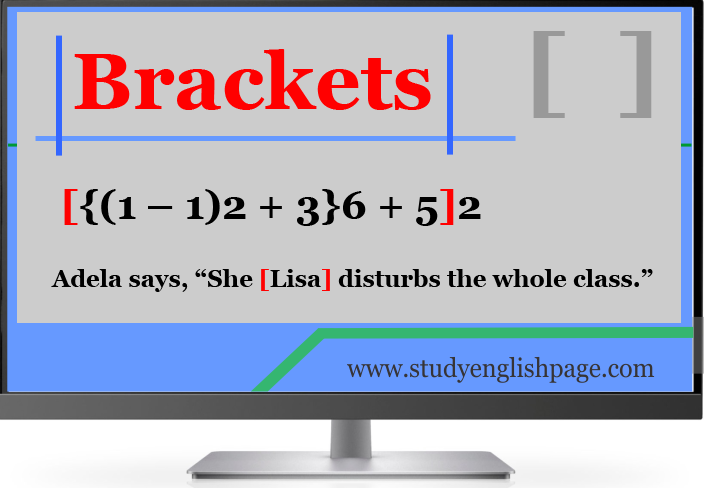Brackets
Brackets are punctuation marks
that we use in pairs. We use the brackets to show explanations, insertion,
corrections, clarification, and comments in direct quotations. They are also
used in mathematical equations to show the order of operation.
- Lisa says, “He [my brother] encouraged me to start a new business.”
- 2[5 + 6{3 + 2(1 – 1)}]
Uses of Brackets
In Quotations
To Explain Something
Sometimes,
we need to add words within a quote from our side for clarification. The words
are not spoken by the original speaker.
- Adela says, “She [Lisa] disturbs the whole class.”
To Indicate Errors
We
use the word “sic” inside the brackets to show that the text in the quotation
is in its original form. It tells that the error was in the original text.
- Ali said, “He dicturbs [sic] me every day.”
To Replace Something
We
often use brackets when we want to replace words or pronouns in quotes. This
makes the reader understand what the words are referring to.
- Our principal said, “There is no place for [John] in our school.”
In
this example, the word “John” replaces the pronoun “he”.
To Show Omitted Text
We
use ellipses within brackets in quotations to show that some irrelevant
information has been omitted and the information has been made simplified.
- “All the teachers were directed to make papers on students learning outcomes base. There were also some other directions […].”
To Add Emphasis
The
tone has great importance in one’s speech, but it is difficult to indicate in
text. A writer can use italic or bold text to indicate the tone and mention in
brackets that it has been done.
- Lisa told me, “I will not allow him [emphasis added].”
To Translate a Foreign Language
When
a direct quote has a foreign language, and you want to make it easier for your
reader, you can write its translation within brackets.
- When I was wandering, I heard, “Kia mai ek sawal poch sakta ho? [Can I ask you a question?]”
To Change Tense
Brackets
can be used in quotes to change the tense. We change the tense in a quote just
to make it understandable.
- “John and Lisa [are] summarizing the essay.”
In
the above example, the word “are” has been altered. The exact words of the
speaker are “John and Lisa have been summarizing the essay.”.
To Change Case
If
you blend a quote into a sentence, there may be a mismatch of the cases. In
this situation, you can use brackets to alter the uppercase letter or lowercase
letter.
- On the agenda, they stated that “[e]mployees should arrange one outgoing recreational activity.”
To Censor
If a quote contains foul language, you can use brackets
inside the quotations to avoid including censored words. It is the best option
when you do not want foul language for your audience.
- Our father told, “They must be [expletive] the party.”
Brackets within Parentheses
As
we know that parentheses are used for additional information. When we want to
insert additional information within parentheses, we use brackets around the
information.
- Today, I was searching for a book in my bookcase. I found many books (biographies, storybooks, and history [Islamic] books.
Brackets in References
We
use brackets in a text when we give references to sources. You may have seen
brackets having numbers inside in research papers. The numbers inside the
brackets show that references to the sources are given in the reference list
according to the numbers written in the brackets.
- Training has a direct relation with the performance of an organization [1].
Brackets in Mathematical Expressions
Brackets (square brackets) are used in some
mathematical expressions. In complex mathematical expressions, a specific order
of operation is followed. Mathematical values inside the square brackets are
solved after all other brackets.
- 7[5 + {5(4 + 5)}]

